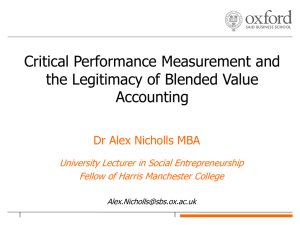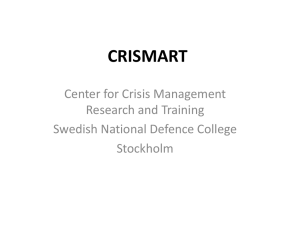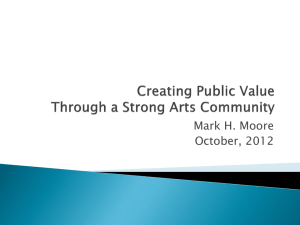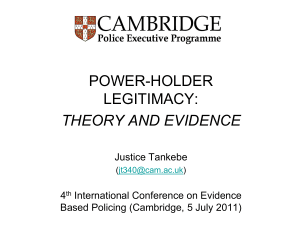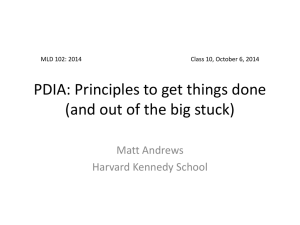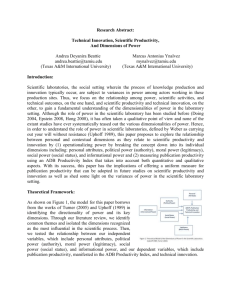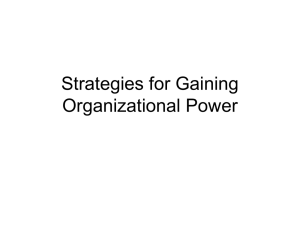The Role of Legitimacy in Social Enterprise
advertisement
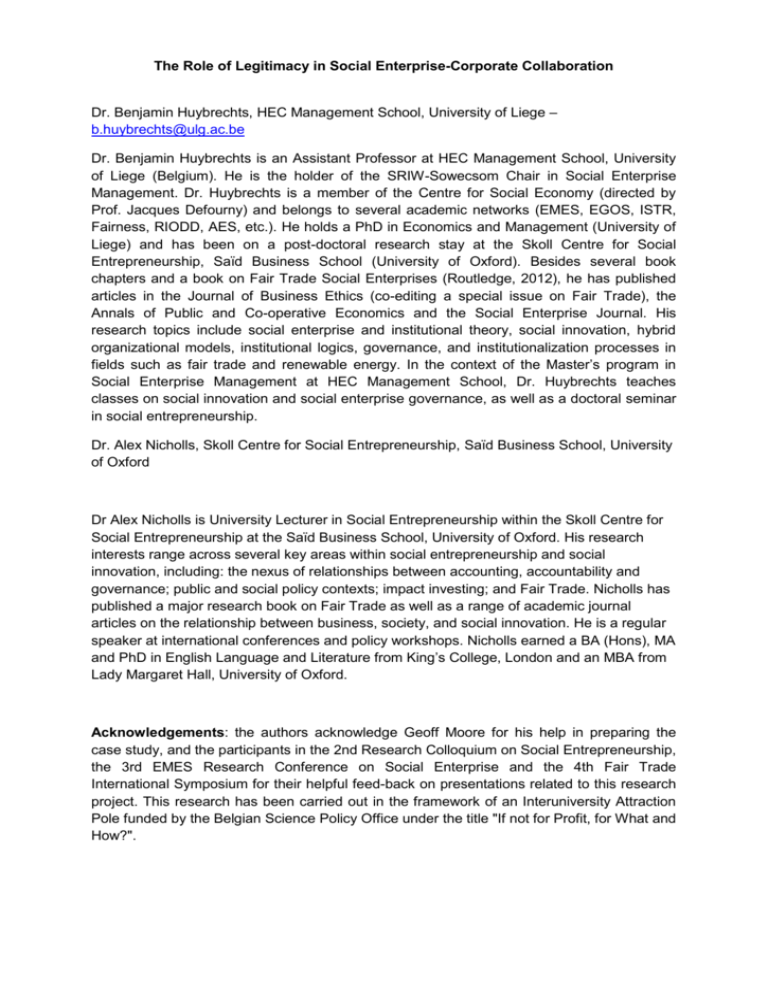
The Role of Legitimacy in Social Enterprise-Corporate Collaboration Dr. Benjamin Huybrechts, HEC Management School, University of Liege – b.huybrechts@ulg.ac.be Dr. Benjamin Huybrechts is an Assistant Professor at HEC Management School, University of Liege (Belgium). He is the holder of the SRIW-Sowecsom Chair in Social Enterprise Management. Dr. Huybrechts is a member of the Centre for Social Economy (directed by Prof. Jacques Defourny) and belongs to several academic networks (EMES, EGOS, ISTR, Fairness, RIODD, AES, etc.). He holds a PhD in Economics and Management (University of Liege) and has been on a post-doctoral research stay at the Skoll Centre for Social Entrepreneurship, Saïd Business School (University of Oxford). Besides several book chapters and a book on Fair Trade Social Enterprises (Routledge, 2012), he has published articles in the Journal of Business Ethics (co-editing a special issue on Fair Trade), the Annals of Public and Co-operative Economics and the Social Enterprise Journal. His research topics include social enterprise and institutional theory, social innovation, hybrid organizational models, institutional logics, governance, and institutionalization processes in fields such as fair trade and renewable energy. In the context of the Master’s program in Social Enterprise Management at HEC Management School, Dr. Huybrechts teaches classes on social innovation and social enterprise governance, as well as a doctoral seminar in social entrepreneurship. Dr. Alex Nicholls, Skoll Centre for Social Entrepreneurship, Saïd Business School, University of Oxford Dr Alex Nicholls is University Lecturer in Social Entrepreneurship within the Skoll Centre for Social Entrepreneurship at the Saïd Business School, University of Oxford. His research interests range across several key areas within social entrepreneurship and social innovation, including: the nexus of relationships between accounting, accountability and governance; public and social policy contexts; impact investing; and Fair Trade. Nicholls has published a major research book on Fair Trade as well as a range of academic journal articles on the relationship between business, society, and social innovation. He is a regular speaker at international conferences and policy workshops. Nicholls earned a BA (Hons), MA and PhD in English Language and Literature from King’s College, London and an MBA from Lady Margaret Hall, University of Oxford. Acknowledgements: the authors acknowledge Geoff Moore for his help in preparing the case study, and the participants in the 2nd Research Colloquium on Social Entrepreneurship, the 3rd EMES Research Conference on Social Enterprise and the 4th Fair Trade International Symposium for their helpful feed-back on presentations related to this research project. This research has been carried out in the framework of an Interuniversity Attraction Pole funded by the Belgian Science Policy Office under the title "If not for Profit, for What and How?". Abstract Purpose – This article explores the role of organizational legitimacy in understanding the emergence and development of ‘cross-sector collaboration’ between social enterprises and corporations. Design/methodology/approach – An in-depth case study of a long-standing but fragile partnership between a UK-based Fair Trade social enterprise and a large corporate retailer provides exploratory findings on the role of legitimacy at different stages of the collaboration process. Findings – The findings highlight how pragmatic and moral legitimacy are mobilized by the social enterprise to justify collaboration throughout three major stages: (1) the very decision of cross-sector collaboration, (2) the choice of the partner and the framing of the partnership, and (3) the evolution of the collaboration. Research limitations/implications – While Fair Trade is not the only sector in which social enterprise-corporate partnerships take place, it has been a pioneering domain revealing the potential as well as the challenges of such partnerships. Taking into account the role of legitimacy throughout the collaborative process is crucial both for comprehensive research and for informed practice. Originality/value – Although it is documented by a single case study, this paper opens new research avenues to examine social enterprise-corporate collaborations by developing a ‘non-functionalist’ view of such collaborations and showing the importance of legitimacy in understanding why and how they emerge, develop and sometimes fail. Keywords: social enterprise, cross-sector collaboration, corporate partnerships, organizational legitimacy, fair trade, UK Article Classification: Research paper 1. Introduction Social enterprises are distinct from both for-profit businesses and public agencies. Yet, they do of course establish partnerships and alliances with these key actors. The “cross-sector” partnerships bringing together different types of organizations have received a growing attention, including nonprofit-public collaborations (Young, 2000, Rushton and Brooks, 2007) and “nonprofit/for-profit” or NGO-business partnerships (Abzug and Webb, 1999, Austin, 2000, Berger et al., 2004, Galaskiewicz and Colman, 2006, Seitanidi and Crane, 2009, Herlin, forthcoming). This article focuses on social enterprises, broadly defined here as organizations pursuing a social mission through their economic activity (Borzaga and Defourny, 2001, Defourny and Nyssens, 2006). Besides working together with local and national governments, social enterprises regularly interact with corporations, leading in some cases to the emergence of social enterprise-corporate partnerships (Di Domenico et al., 2009). It is suggested here that these collaborations differ from both philanthropic partnerships and classical business alliances. Unlike the former, these collaborations are centred on the joint development of a product or service which represents a business opportunity for both the social enterprise and the corporation. Unlike the latter, these collaborations contribute at least partly to the pursuit of a social mission, which lies at the heart of the social enterprise DNA. Examples of social enterprise-corporate collaborations can be found in several geographical areas (North and South) and fields, from recycling and community housing to microfinance and Fair Trade. In the North, cross-sector collaborations have flourished over the last years through a broad range of settings (bi- or multilateral) and governance mechanisms, partly under the impulse of support structures and public agencies. In the UK, for instance, governmental support to social enterprise (now located at the Cabinet Office) has been instrumental in leveraging such type of partnerships (DTI, 2005). In the South, the interest of corporations in accessing “bottom-of-the-pyramid” (BOP) markets, which has received an increasing attention, has also offered opportunities for cross-sector collaboration (Webb et al., 2010). Famous examples include the Grameen Bank, which has built joint ventures with several corporations: telecommunications (with Nortel), nutrition (with Danone), health (with BASF) and, recently, drinkwater (with Veolia). Most work on cross-sector collaboration examines the advantages of collaboration for the different types of organizations (e.g., O’Regan and Oster, 2000, Austin, 2000). We take a different perspective, using institutional theory to look at the role of collaboration in terms of organizational legitimacy in motivating or hindering the emergence and evolution of crosssector partnerships. In our view, cross-sector collaborations between social enterprises and corporations share two features which raise crucial issues in terms of organizational legitimacy: singularity (these collaborations are unusual) and ambiguity (they bring together multiple and potentially contradictory institutional logics). First, these collaborations do not neatly fall into familiar categorizations (as do, for instance, public-nonprofit partnerships). As “hybrid organizations” (Battilana and Dorado, 2010), social enterprises are, already, a recent and unusual organizational form (e.g., Dart, 2004); their collaboration with corporations is therefore not more “taken for granted” than their very existence. Secondly, as organizational legitimacy is contingent on a given institutional field in which a number of stakeholders provide legitimacy based on patterns of appropriateness (Aldrich and Fiol, 1994), managing legitimacy becomes particularly challenging when organizations from different fields embodying different logics and responding to various legitimating stakeholders collaborate (Stryker, 2000). In fact, the very concept of social enterprise reflects an evolution towards blurring boundaries between distinct and potentially conflicting institutional orders: civil society and the market (Grenier, 2006, Garrow and Hasenfeld, 2012, Tracey et al., 2011). The collaborations between social enterprises and corporations may thus be seen as embodying the shift in these institutional boundaries at the same time as they participate in blurring them. Surprisingly, while institutional theory has become a widely used theoretical framework, it has only little been applied to examine interorganizational collaboration (Phillips et al., 2000), let alone cross-sector collaboration (Herlin, forthcoming), let alone collaboration between social enterprises and corporations. This article contributes to filling this research gap. In the next section, we introduce the theoretical background. We propose a short overview of the literature on interorganizational collaboration, the institutional and legitimacy-based perspectives, and the particular case of social enterprise-corporate cross-sector collaboration involving social enterprises. In the third section, the methodology is presented, with a particular focus on Fair Trade as an illustrative field in which one case study is explored. The fourth section exposes the findings, based on legitimacy roles at three stages of the collaborative process in the particular case examined here. The fifth section concludes, opening trails for future research in this field. 2. Theoretical background Interorganizational collaboration and institutional theory Interorganizational collaboration is “a co-operative relationship among organizations that relies on neither market nor hierarchical mechanisms of control” (Phillips et al., 2000, 24). This type of interorganizational relationship thus differs from both classical market relationships (such as buyer-seller) and hierarchical subordination mechanisms (where one of the parties, for instance the government, has authority to impose collaboration). Most of the extant research has focused on the advantages of collaboration, depicted as a solution enabling organizations to reduce uncertainty (Pfeffer, 2003, Ahuja, 2000), share information and promote innovation (Pfeffer and Salancik, 1978), reduce transaction costs (Williamson, 1985, Dyer, 1997), access and create new resources (Dyer and Singh, 1998), all of which are said to provide competitive advantages that these organizations, especially smaller ones (BarNir and Smith, 2002), would not have enjoyed without the collaboration (Dyer and Singh, 1998, Child and Faulkner, 1998). The rationale of collaboration and the processes and conditions of negotiation are also commonly linked to these expected advantages, thereby taking a functionalist view on collaboration, based on what the organizations and their different stakeholders can gain from it. By focusing on the functional aspects of collaboration, researchers tend to overlook other drivers that may explain an important part of why and how organizations collaborate. One of these drivers is legitimacy. Legitimacy lies at the core of institutional theory, which for several decades has explored the dynamics of institutional fields and their relationships with organizational behaviour (DiMaggio and Powell, 1983, Meyer and Rowan, 1977). From an institutional perspective, interorganizational collaboration is interesting precisely because it connects the macro (field) and micro (organizational) levels, which have often been examined separately. As stated by Lawrence et al. (2002, 281): “Institutional theory has tended to focus on field-level dynamics over relatively long periods of time and has spent relatively little time exploring the micro sources of these macro changes. Research on collaboration, on the other hand, has tended to focus on immediate outcomes for participating organizations while largely ignoring the macro effects of collaboration on the institutional fields in which they occur”. Interorganizational collaboration can be seen, more precisely, as a phenomenon located at the interface between macro, field-level institutional trends, and micro, organizational-level dynamics. On one side, institutional pressures favour or hinder interorganizational collaboration and shape to a certain extent the behaviour of each organization in the collaboration process. As stated by Phillips et al. (2000, 29), “[t]he participants in a collaborative process bring with them various institutional affiliations and the institutionalized rules and resources that this implies”. Focusing on collaborations only as products of external institutional dynamics, however, neglects the organizations’ potential for agency, more particularly the “strategic use of institutionalized rules and resources” (30). Indeed, as institutions are social constructions (DiMaggio, 1988, Leca et al., 2008), interorganizational collaboration precisely appears as a locus of institutional construction and transformation. By examining both dimensions –collaboration as a process of both institutional conformity and agency–, Gidden’s (1984) dual interaction between agency (in which collaboration may be located) and structure (institutions) is recalled: “engaging in collaborative action is dependent on the invocation of rules and resources at the same time as it serves to reproduce them” (Phillips et al., 2000, 34). Surprisingly, while legitimacy is a core concept throughout institutional theory, it has not been central in institutional accounts of interorganizational collaboration (see Herlin, forthcoming for a review). Legitimacy has received an increasing attention in organization theory from the 1970s (Deephouse and Suchman, 2008). Early neo-institutionalists defined organizational legitimacy as “the adequacy of an organization as theory” (Meyer and Rowan, 1977), referring to the cognitive dimension of legitimacy. For Scott (2000), organizational legitimacy is a “condition reflecting cultural alignment, normative support, or consonance with relevant rules or laws”. One of the most commonly used definition in Suchman’s (1995) pivotal article, in which he referred to a “generalized perception or assumption that the actions of an entity are desirable, proper, or appropriate within some socially constructed system of norms, values, beliefs, and definitions” (574). Finally, in the context of social entrepreneurship, Nicholls (2010b) provides the following definition: legitimacy is “the congruence, in multiple stakeholder judgements, of an organization’s perceived actions with their expectations of its performance”. Authors commonly distinguish among different types of legitimacies based on the avenues through which compliance occurs. Aldrich & Fiol (1994) oppose cognitive legitimacy (linked to the “taken-for-grantedness” of the legitimated subject) and sociopolitical legitimacy (induced by the compliance with laws and norms). Suchman (1995) and Scott (2000) break up the latter into two categories and suggest a broadly similar typology consisting of three types of legitimacies: pragmatic or regulative legitimacy (compliance induced by a regulatory entity and/or motivated by access to resources and advantages), moral or normative legitimacy (compliance with norms and values) and cognitive legitimacy. Each of these legitimacies is again subdivided into a range of sub-categories. Nicholls (2010b) adds associational legitimacy, induced by “association with other entities that are already perceived to be more legitimate”. Legitimacies are also commonly distinguished based on the level of analysis: individual, organizational, field legitimacy etc. Finally, as discourse is central in institutional analysis, there has been a special attention of institutionalists to discursive legitimacy – the “ability to speak legitimately for issues or other organizations” (Hardy et al., 2005, Phillips et al., 2000, 33). Collaboration between social enterprises and corporations Different terms are used in the emerging literature and refer to different understandings of social entrepreneurial initiatives. Such heterogeneity may be linked, at least partly, to different levels of analysis: “social entrepreneurship” may be seen as the dynamic process through which specific types of individuals deserving the name of “social entrepreneurs” create and develop organizations that may be defined as “social enterprises” (Mair and Marti, 2006, Defourny and Nyssens, 2008, Defourny and Nyssens, 2010). Several authors nevertheless consider that “social entrepreneurship” designates a wider range of initiatives, not necessarily taking the form of “social enterprises” (Nicholls, 2006, Thompson, 2008, Huybrechts and Nicholls, 2012). For certain authors, social enterprises are just a more fashionable way to designate nonprofit organizations that have accentuated their commercial profile. This new term would thus embody the commercialization of the nonprofit sector as a result of an isomorphic attraction by the dominant market institution (Dart, 2004). Other authors see social enterprises at the interface between nonprofits and cooperatives, highlighting the combination of a social mission backed by a not-for-profit structure and an entrepreneurial, market-oriented dynamics. The EMES European Research Network defines social enterprises as “not-forprofit private organizations providing goods and services directly related to their explicit aim to benefit the community. They rely on a collective dynamics involving various types of stakeholders in their governing bodies, they place a high value on their autonomy and they bear economic risks linked to their activity” (Defourny and Nyssens, 2008:5). Finally, social enterprise can be seen as an umbrella term for a set of organizational vehicles more or less rooted in the third sector and using the market to pursue social aims (Dees, 2001). Partnerships between social enterprises and corporations logically share common features with those between “nonprofit” and “for-profit” organizations, as described by several authors (Austin, 2000, O’Regan and Oster, 2000). These features often relate to the differences between the organizations on various aspects: governance structure, mission, culture, staff, etc. Collaboration is commonly explained through the assumption that the difference and asymmetry between the organizations on these aspects bring complementary dynamics and efficiency prospects which favour collaboration. In this context, the theoretical approaches used examine these collaborations draw on strategy (Berger et al., 2004, Austin, 2000), transaction cost economics (O’Regan & Oster, 2000) and resource dependence/stakeholder theory (Abzug and Webb, 1999). A number of studies on cross-sector and more particularly social enterprise-corporate partnerships, however, shift away from the functionalist accounts which dominate the literature in this field. Di Domenico et al. (2009) use social exchange theory to examine the dialectical forces in cross-sector collaboration, identifying contradictions in terms of goals, ownership, governance, and accountability. In the field of Fair Trade, Davies (2009) uses network theory and identifies six types of relationships linking social enterprises with a variety of other organizations, based on the homogeneity of their goals and resources. None of this work, however, deals with the role of social enterprise legitimacy in understanding crosssector collaboration. In a context of bridge-building between diverse institutional logics, i.e. between diverse legitimating stakeholders and legitimation criteria, participants will need to determine from which institutional fields the guiding principles of the collaboration will be mainly borrowed (Phillips et al., 2000). In cross-sector collaborations involving social enterprises, the latter’s explicit market orientation may lead to easing the adoption of market norms and values as the guiding principles. The social enterprise ambiguity due to diverse and potentially conflicting institutional logics could, in a certain sense, lead to its subordination to the corporation as the dominant partner. As a matter of fact, legitimacy seems closely linked to power. However, the link between the two concepts, especially in the context of collaboration, remains unclear. One possible link is suggested by Phillips et al. (2000) who propose that discursive legitimacy influences the ability of each partner to influence the collaborative structures and practices. Discursive legitimacy may compensate for the lack of two other sources of power, namely critical resources and formal authority (Hardy and Phillips, 1998). Phillips et al. (2000) suggest that this explains why “resource-poor” actors such as environmental groups have been able to dominate collaborations with “resource-rich” corporations. Certain social enterprises might also enjoy high levels of discursive legitimacy, thereby reaching a more balanced power distribution with corporations. A three-step collaborative process Following institutional authors, it is suggested here that organizational legitimacy plays a crucial role at different steps of the collaborative process. Three steps can be distinguished in this process, each of which can be analyzed through the lens of organizational legitimacy. A first momentum prior to any action is the very idea of collaboration across institutional fields. Hence, we wonder whether the search for organizational legitimacy in one’s institutional field may be a driver for cross-sector collaboration, besides functional prospects (access to resources, economies of scale, etc.). Normative drivers are likely to play an important role. The general evolution and the very concept of social enterprise embody a growing trend of inclusion of market-related norms and practices in these initiatives. Indeed, compared to more established conceptualisations of “nonprofit organizations” or “charities”, the language surrounding social enterprises emphasises values linked to risk-taking, efficiency and professionalism, which appear more legitimate even for organizations pursuing social aims (Dart, 2004, Nicholls and Cho, 2006, Grenier, 2006). In this context, the practice of collaboration with corporations, as the organizations that most explicitly embody the dominant business paradigm, would be naturally encouraged as “morally legitimate” by the stakeholders promoting the social enterprise approach. Other stakeholders that are more reluctant towards market-based approaches, however, are likely to view partnerships with corporations as the ultimate compromise of principle putting the door wide open to market isomorphism. Indeed, the partnerships with businesses can be seen both as the result of a stronger commercial orientation of these organizations, and as a driver of their “business-like” evolution. In such sense, the partnerships with corporations constitute a particularly well suited locus to examine the normative influences faced and reinforced by social enterprises. On the other side, corporations are increasingly communicating about their social responsibility and tend to include the pursuit of social purposes in their declared missions. Whether this constitutes a real normative shift is debatable, as the interest in social purposes can also be interpreted as “take-over” of social issues by actors primarily concerned with profitability (Yang and Rivers, 2009, Doh and Guay, 2006, Seitanidi and Crane, 2009, Hess and Warren, 2008). In this context, collaboration with social enterprises appears as a way for corporations to demonstrate the meaningful and not only symbolic (Hess and Warren, 2008) commitment to social goals (Seitanidi and Crane, 2009). Such collaborations thus appear as normatively favoured both in the business world and in the broader society: public authorities, consumers, advocacy groups, etc. As a result, the collaboration between corporations and social enterprises could embody the bridge-building of and blurring boundaries between two previously well distinct institutional orders. The idea of cross-sector collaboration is also likely to be stimulated by the prospects of advantages for a number of internal and external stakeholders (pragmatic legitimacy). Stakeholder perceived benefit may be direct (e.g., new products for customers, new market opportunities for suppliers, new jobs, etc.), or indirect, through an improved situation for the organization that then benefits these stakeholders (e.g. organizational growth, profitability, reputation benefitting to employees or shareholders). Direct benefits are linked to outputs, directly deriving from the collaboration, which are tangible for these stakeholders A second step in the collaborative process is what Gray (1989) and Phillips et al. (2000) call the “membership” of the collaboration. How does each organization a priori define which of the participants across the sector boundary may qualify as potential partners? This also relates to the collaboration framing: what does each organization achieve through the collaboration, what problems does it want to solve that it could not solve alone, what are the conditions under which it accepts to collaborate? Both the social enterprise and the corporation will seek collaboration as a solution for a specific problem that they have shaped according to their norms and habits. Social enterprises are likely to collaborate with corporations because this will better enable them to address the social issue which constitutes their raison d’être. Hence, the purpose of the collaboration from the social enterprise standpoint will be framed according to its contribution to the achievement of the social mission. The social enterprise is thus likely to identify the corporations that are compatible with its missions –or, at least, to reject those that are deemed incompatible. In doing so, it will try to avoid a negative associational reputation. The corporation, on its side, is likely to search for both an economic and an image benefit. While the economic benefit requires a framing corresponding to a profitable business opportunity, the image benefit relies on association with a social enterprise enjoying a good reputation. Obviously, the preferences of each organization in terms of membership of collaboration are constrained and influenced by the configuration at the other side of the (potential) collaboration. It may be that no candidates match an organization’s membership criteria, or that the framing of the collaboration does not resonate with that of the potential cross-sector candidates. More realistically, the membership criteria are likely to be adapted to the available opportunities, and the framing of the collaboration will have to be adjusted to the situation and preferences at the other side of the collaboration. For instance, a theoretically unsuitable corporation might bring pragmatic arguments that would lead the social enterprise to rethink its boundary line or engage in discursive maneuvers to justify collaboration with businesses that did not initially correspond to the desired profile. Throughout this adjustment process, patterns of dominance will be crucial among organizations and, more broadly, between their respective fields. Finally, the third step which is of interest in terms of organizational legitimacy is the evolution of the collaboration, with all its possible options: extension, reduction, stabilization, or ending. Again, the decisions of where to take the collaboration are likely to be shaped by the patterns of dominance among the partners. More precisely, we suspect that decisions concerning the evolution of the collaboration will be appropriated by the partner that is the least dependent on it, which means that it has the highest number of alternative legitimate options. This article aims to document the role of organizational legitimacy throughout the three phases of social enterprise-corporate collaboration. The following figure depicts these phases and summarizes the possible roles of legitimacy throughout these phases. Figure 1: Collaboration phases and roles of legitimacy Decision of cross-sector collaboration Is cross-sector collaboration adequate? Is cross-sector collaboration legitimate? For whom and why? Evaluation Membership Who can be a partner? Which partner is legitimate (for which stakeholders)? Is the partnership succesful and viable? How does the evolution of the partnership link with organizational legitimacy? 3. Methodology As the partnerships between social enterprises and corporations constitute a largely underresearched issue, even more from an institutional and legitimacy-based perspective, the case study method was favoured to explore the research question and generate theoretical propositions. An in-depth case study was chosen to highlight the role of organizational legitimacy throughout the collaboration phases. Fair Trade (FT) was chosen as an illustrative field given its number of and relatively long experience in cross-sector collaboration. FT includes a broad diversity of actors which are involved to various extents in the trading (or labelling) of products that meet the FT standards (Huybrechts and Reed, 2010). On the one side, Fair Trade social enterprises have a 100% commitment to FT – they combine economic, social and political goals and strive for coherence between the FT principles and their own organization model (Huybrechts, 2012, Huybrechts, 2010, Huybrechts and Defourny, 2008). On the other side, the largest part of FT sales is generated by corporations, including mainstream brands and retailers (Nicholls, 2010a). While corporate participation has received criticism due to dilution of the ethical values and cooptation of the FT social movement, it initially resulted from a joint effort of pioneer FT social enterprises and NGOs themselves (Nicholls and Opal, 2005, Huybrechts et al., 2006). According to Davies, “alliances and inter-company networks have been purposefully embedded in the fair trade industry since its modern foundations” (2009, 109). While with non-labelled products such as handicraft and part of food products, corporations need to collaborate with FT social enterprises to enter the sector, with products labelled by Fairtrade International (formerly FLO-I) collaboration is not required for corporations and is thus optional (Reed, 2009). This latter type of collaboration will be focused on here because the role of legitimacy in informing the choices of whether, how and with whom to collaborate is more salient than in the standardized patterns of labelled products (for an analysis of FT partnerships mediated by the label, see Nicholls and Huybrechts, 2010). The collaboration between a British FT pioneer (FTSE) and a large corporate retailer (CORP) was purposefully selected for the role that organizational legitimacy seemed to play or have played at the different phases described here. FTSE had long experience in working with producer groups in developing countries to import both food and non-food products into the UK. Their products were distributed through a network of grass-roots volunteers and through mainstream retailers from the mid-1990s. Among these retailers, CORP sold FTSE products including tea and handmade cards. The focus here was laid on organizational legitimacy from the social enterprise standpoint. The people involved in the negotiations prior to and during the collaboration were interviewed, as well as a number of key informants, throughout a period ranging from January 2008 to September 2010. All the organizational documents including information about the collaboration were carefully examined (annual reports, memos, internal documents, etc.). Then, interview transcripts and document abstracts were mapped against the different types of legitimacies throughout the three collaboration phases. 4. Findings Decision of cross-sector collaboration When asked about the role of legitimacy in the decision of cross-sector collaboration, the interviewees at FTSE downplayed its influence and insisted on the much greater role of economic benefits. Commenting on these, nevertheless, they developed arguments which could be clearly linked to both pragmatic and moral legitimacy. Interesting was that the interviewees depicted collaboration as a solution enabling simultaneous compliance to very diverse expectations: “the main reason [for us to collaborate] is to increase the sales volume to improve the producers’ development [opportunities], our economic viability and the further advancement of the FT movement” (Interviewee 2). Such convergence of pragmatic and moral arguments across stakeholders was raised in the interviews and in the documents and can be linked to the broader FT movement rationale for corporate partnerships. Interestingly, the interviewees associated stakeholders, in particular producers, to the decision of collaboration. As producers were the key beneficiary to which the whole social mission was oriented, framing them as the main driver of cross-sector collaboration was a particularly legitimate claim. Interviewees suggested that producers were among the most enthusiastic supporters of the collaboration because it would have considerable impact on their revenues and thus their livelihoods. The interviewees also pointed to compliance with expectations from people who had a stake in FTSE’s economic health (shareholders and employees). Beyond pragmatic arguments, the interviewees reported an unanimous feeling among stakeholders, including within the social enterprise, that corporate collaborations were “the right thing to do” insofar as it contributed to the social mission of improving the producers’ livelihoods. It is interesting to note that the pragmatic advantage for producers was precisely used as a moral support for other stakeholders for whom pragmatic considerations are less relevant. Surprisingly, no single reference was made to any criticism from any stakeholder in the FT movement or beyond, while such criticism is clearly documented in studies examining stakeholders, including producers themselves (e.g., Auroi and Yepez del Castillo, 2006). This raises the importance of the context of the collaboration, insofar as in contrast with other countries (such as France or Italy), FT has been conceived and promoted in the UK in a way that makes corporate participation cognitively legitimate, in the sense that FT without corporations (i.e., outside any supermarket or mainstream brand) would now be virtually unthinkable. Collaboration membership While the principle of cross-sector collaboration was presented as naturally legitimate, the question of who to collaborate with, and on what basis, was less evident. The interviewees indicated that they had learned from earlier collaborations to be better prepared, both in economic and social terms: “we used to do [things] very informally but then we felt the need to work on some guidelines about, you know, why we do it, how we should negotiate and how we should choose the best partner” (Interviewee 2). The managers also suggested that the social mission should be at the centre of any collaboration: “the most important for us is to monitor the supply chain: as long as they work with our producers and pay a fair price, we’re happy” (Interviewee 1). FTSE claimed that it carefully screened the potential partners, with the help of an internal policy unit and other NGOs, before engaging in collaboration. However, the treshold seemed relatively low in the sense that the main concern was to avoid corporations with a too negative reputation. It is clearly in terms of partner choice that legitimacy in the eyes of the FT movement was invoked: “you know, we’re open, but we know we cannot work with anyone. We know we would be in trouble if we announced we’d go with Nestlé or so” (Interviewee 1). Several interviewees mentioned that FTSE would ideally prefer a corporate partner with a similar size: large enough to be economically interesting, but not too large to avoid a potentially negative associational reputation as well as a too large power asymmetry. While this was possible with certain manufacturers, it was impossible with mainstream retailers. CORP is an example of a relatively low engagement: while it accepted the conditions corresponding to the FT standards, with FTSE “bringing” the producer groups and suggesting “fair” prices, CORP refused to sign a formal agreement including, for instance, a minimal duration for the collaboration. Evolution of the collaboration Duration leads us to the third and final step in the collaborative process: its evaluation and evolution. Up to this point, CORP unilaterally decided about whether to extend the collaboration every year, and how to conceive and display the cards (most strikingly regarding the sizes of the “FTSE” and “CORP” respective logos). Every year, the quantities were raised, but the visibility of FTSE decreased. Given the lack of formal agreement, the interviewed managers admitted that they totally depended on CORP’ decisions. In fact, for CORP, the associational legitimacy of working with FTSE did not impede behaviours linked to classical supplier-buyer relationships, where the corporate retailer clearly has the power. These behaviors were limited, however, by the relative dependence on FTSE that was clearly mentioned as a key partner of the CSR strategy. The framing of the collaboration was thus very different according to the standpoints, signaling an initial power asymmetry: while CORP had resources which were critical for FTSE –a large retailing network and a solid reputation–, the reverse was less obvious. Up to this point, FTSE was nearly the only possible supplier of FT cards in the UK and had an excellent ethical reputation allowing for a positive associational reputation –to such a point that it was the first “external”, non-CORP brand to enter CORP stores. This, however, may be subject to change. Indeed, with “nonfood” products increasingly labeled by Fairtrade International, other suppliers might enter the market with lower prices and become potential partners for CORP from the moment that they are not deemed illegitimate by the FT movement (which is clearly the case when the certification applies). Again, this shows how the context has a major influence on the legitimacies and power relations underlying cross-sector partnerships. Interestingly, the history of previous collaborations seemed to play an important role in the trust among the partners. FTSE experienced breakout of a collaboration with a corporate retailer with which there actually was a clear value alignment. The collaboration ceased when the product category became available for certification and the retailer preferred an ownbranded solution, linking directly with producer groups. This seemed to have an influence on FTSE’s general trust in the retailer’s world, for instance: “the day cards get the [FT] mark, we’ll be out [of the collaboration]: if [another retailer] did it, they [CORP] won’t hesitate […]” (Interviewee 2). Interviewee 1 suggested the persistence of associational reputation for the corporation, whatever the evolution of the collaboration: “they [CORP] know customers won’t mind if tomorrow they stop [working] with us, you know they [customers] won’t notice it, it’s just important they’ve [CORP] been associated with us or with another [Fair Trader] at one moment”. A possible evolution raised by one interviewee would be for CORP to directly import from the producers without any role for FTSE. This would put the latter in an ambiguous situation in which it would support this evolution from a moral perspective but it would lose pragmatic benefits. This corresponds to a classical debate in FT and more generally social entrepreneurship about the question of whether social enterprises are relevant from the moment that their social mission is better achieved by other agents (public authorities or, in this case, corporations). The main source of power for FTSE seemed to be reputation and discursive legitimacy. The interviews suggested that the ability of FTSE to speak legitimately for producers and the broader social movement around FT was a source of power enabling them to become valid interlocutors for corporations. The willingness of numerous corporations to participate in FT through trading labeled goods strongly depends on the discursive legitimacy of labelers. However, insofar corporations can trade labeled goods without engaging in collaboration with social enterprises, there is a risk that the latter lose their specific asset. This was rejected by the interviewees, who suggested that stakeholders supported the collaboration as a morally better arrangement than labeling only: “people say: yeah, we’re not fans of CORP, but it’s better to work with them, try to influence them, [rather than] leave them using the [FT] label with no control” (Interviewee 1). Throughout the different steps of the collaborative process, it appeared that the dominant logics were predominantly market-based. This confirms how corporations attempt –and in this case manage– to include social issues and improve their corporate image without compromising any of their economic principles. This is consistent with Phillips and colleagues’ analysis (2000, 33): The pattern of authority, resource dependencies and discursive legitimacy among collaborating organizations will shape the negotiations, with the dominant organizations exerting a more influential role in the development of collaborative structures and practices. We would therefore expect that the institutional fields associated with those dominant members to be more influential in the ongoing production of the collaboration: the problem definition and collaborative practices reflecting the institutionalized rules and resources of the dominant members' fields. However, we do not argue that corporations are necessarily the dominant partner. For instance, the FT label has been analyzed as a device by which FT social enterprises can, under some conditions, precisely protect their own logic and stabilize collaboration in spite of the clear power asymmetries (Nicholls and Huybrechts, 2010). Similar strategies have been observed elsewhere (see for instance Herlin, forthcoming). 5. Conclusion Our purpose was to explore the role of organizational legitimacy in explaining the emergence and development of social enterprise-corporate collaboration. We examined whether the search for legitimacy influenced social enterprises and corporations at three stages of the collaborative process: (1) the very decision of cross-sector collaboration, (2) the choice of the partner and the framing of the partnership, and (3) the evolution of the collaboration. We also examined how patterns of dominance could constrain each organization’s decision throughout these three stages. The interviews at FTSE suggested that collaboration with corporations such as CORP was guided by a search for both pragmatic and moral legitimacy. Pragmatic legitimacy was raised mainly regarding producers and was depicted as the driver for appraisal from other stakeholders (supporting the collaboration insofar it benefitted to the producers). Surprisingly, there was no mention of cross-sector collaboration as an illegitimate behaviour, despite the debates that have pervaded the FT movement (Huybrechts, 2012, see for instance Ballet and Carimentrand, 2010). This confirms the importance of context on legitimacy judgements, with in this case the UK context providing more positive normative background for the development of social enterprise-corporate collaboration than in other European countries (Huybrechts and Reed, 2010) Prior to the collaboration, the framing of the collaboration and the choice of its membership were operated by the social enterprise in a way that would serve its social mission. This initial work, however, was strongly constrained by the availability and the conditions of potential corporate partners. The case of FTSE and CORP clearly showed how the SE’s view on the collaboration, based on its previous experience, was challenged by the corporation’s conditions. The corporation managed to impose its conditions because of its superior power, especially in terms of critical resources. Hence, it is the corporation who chose the social enterprise and not the reverse, demonstrating its dominant position. Other collaborations involving FTSE and other social enterprises showed that, once less costly alternatives appeared for the corporations, either through other social enterprises or without any of them (as is made possible by the labelling system), they did not hesitate to stop the collaboration. Lacking resources which would really be critical and unique, individual social enterprises also seem to lack an exclusive claim on discursive legitimacy. This shows the importance for social enterprises to jointly build discursive legitimacy in order to escape corporate attempts to use competition amongst social enterprises at their advantage –by negotiating with those organizations offering the best conditions at a particular moment. While such collective endeavour has been instrumental in the development of FT (Davies, 2009), this study shows that fierce economic competition and opportunistic behaviour by powerful corporations lead to isolate social enterprises and can ultimately transform the social movement into a classical competitive market. In brief, while social enterprises seem stimulated by most stakeholders to collaborate with corporations, they may not be able to remain as the only legitimate option over time. In this case at least, the social enterprise was not able to shape the collaboration according to its own institutional norms and to maintain their power over time. Market considerations were dominant and seemed to attract the social enterprise without considering legitimacy issues in its original institutional field (the FT movement). The main case here, however, was not to show that corporate domination is a necessary evolution of cross-sector partnerships – several studies have shown how social enterprises can, under certain conditions, build sustainable partnerships despite conflicting logics and power asymmetries (Nicholls and Huybrechts, 2010, Di Domenico et al., 2009). The argument here was to point at organizational legitimacy as a main factor explaining the emergence and development of cross-sector partnerships, either successful ones or failures. Given the limitations of this study to a single case study at one particular time period, other studies are necessary to provide refined empirical evidence and build in-depth theoretical propositions, for instance at each particular phase of the collaborative process, through the lens of one particular stakeholder category, or in the specific situations of conflict. Longitudinal studies would also enable understanding how variations in the context, in the stakeholder configuration or in the organizations’ leadership and governance could impact cross-sector collaboration through an evolution of organizational legitimacies at both sides of the partnership. References ABZUG, R. & WEBB, N. J. 1999. Relationships Between Nonprofit and For-Profit Organizations: A Stakeholder Perspective. Nonprofit and Voluntary Sector Quarterly, 28, 416-431. AHUJA, G. 2000. The duality of collaboration: inducements and opportunities in the formation of interfirm linkages. Strategic Management Journal, 21, 317. ALDRICH, H. E. & FIOL, C. M. 1994. Fools rush in? The institutional context of industry creation. Organization Studies, 19, 645-670. AUROI, C. & YEPEZ DEL CASTILLO, I. (eds.) 2006. Economie solidaire et commerce équitable : acteurs et actrices d’Europe et d’Amérique Latine, Louvain-la-Neuve: Presses Universitaires de Louvain. AUSTIN, J. E. 2000. Strategic Collaboration Between Nonprofits and Businesses. Nonprofit and Voluntary Sector Quarterly, 29, 69-97. BALLET, J. & CARIMENTRAND, A. 2010. Fair Trade and the Depersonalization of Ethics. Journal of Business Ethics, 92, 317-330. BARNIR, A. & SMITH, K. A. 2002. Interfirm Alliances in the Small Business: The Role of Social Networks. Journal of Small Business Management, 40, 219-232. BATTILANA, J. & DORADO, S. 2010. Building sustainable hybrid organizations: the case of commercial microfinance organizations. Academy of Management Journal, 53, 1419-1440. BERGER, I. E., CUNNINGHAM, P. H. & DRUMWRIGHT, M. E. 2004. Social Alliances: Company/Nonprofit Collaboration. California Management Review, 47, 58-90. BORZAGA, C. & DEFOURNY, J. 2001. The Emergence of Social Enterprise, London, Routledge. CHILD, J. & FAULKNER, D. 1998. Strategies of Co-operation. Managing Alliances, Networks, and Joint Ventures, Oxford, Oxford University Press. DART, R. 2004. The legitimacy of social enterprise. Nonprofit Management & Leadership, 14, 411424. DAVIES, I. 2009. Alliances and Networks: Creating Success in the UK Fair Trade Market. Journal of Business Ethics, 86, 109-126. DEEPHOUSE, D. L. & SUCHMAN, M. C. 2008. Legitimacy in Organizational Institutionalism. In: GREENWOOD, R., OLIVER, C., SAHLIN, K. & SUDDABY, R. (eds.) The SAGE Handbook of Organizational Institutionalism. Los Angeles: Sage. DEES, J. G. 2001. The Meaning of “Social Entrepreneurship”. The Fuqua School of Business, Duke University. DEFOURNY, J. & NYSSENS, M. 2006. Defining social enterprise. In: NYSSENS, M. (ed.) Social Enterprise. At the crossroads of market, public policies and civil society. London: Routledge. DEFOURNY, J. & NYSSENS, M. 2008. Social Enterprise in Europe: Recent Trends and Developments. EMES Working Paper, 08. DEFOURNY, J. & NYSSENS, M. 2010. Conceptions of Social Enterprise and Social Entrepreneurship in Europe and the United States: Convergences and Divergences. Journal of Social Entrepreneurship, 1, 32-53. DI DOMENICO, M., TRACEY, P. & HAUGH, H. 2009. The Dialectic of Social Exchange: Theorizing Corporate-Social Enterprise Collaboration. Organization Studies, 30, 887-907. DIMAGGIO, P. 1988. Interest and agency in institutional theory. In: ZUCKER, L. G. (ed.) Institutional patterns and organizations. Cambridge, MA: Ballinger. DIMAGGIO, P. & POWELL, W. 1983. The Iron Cage Revisited: Institutional Isomorphism and Collective Rationality in Organizational Fields. American Sociological Review, 48, 147-160. DOH, J. P. & GUAY, T. R. 2006. Corporate social responsibility, public policy, and NGO activism in europe and the United States: An institutional-stakeholder perspective. Journal of Management Studies, 43, 47-73. DTI 2005. Match winners: A guide to commercial collaborations between social enterprise and private sector business. London: Social Enterprise Unit, Department for Trade and Industry. DYER, J. H. 1997. Effective interfirm collaboration: how firms minimize transaction costs and maximize transaction value. Strategic Management Journal, 18, 535-556. DYER, J. H. & SINGH, H. 1998. The relational view: cooperative strategy and sources of interorganizational competitive advantage. Organization Studies, 23, 660-679. GALASKIEWICZ, J. & COLMAN, M. S. 2006. Collaboration between Corporations and Nonprofit Organizations. In: POWELL, W. & STEINBERG, R. (eds.) The Nonprofit Sector. A Research Handbook. New Haven: Yale University Press. GARROW, E. & HASENFELD, Y. 2012. Managing Conflicting Institutional Logics: Social Service versus Market. In: GIDRON, B. & HASENFELD, Y. (eds.) Social Enterprises: An Organizational Perspective. Palgrave/Macmillan. GRENIER, P. 2006. Social Entrepreneurship: Agency in a Globalizing World. In: NICHOLLS, A. (ed.) Social Entrepreneurship. New Models of Sustainable Social Change. Oxford: Oxford University Press. HARDY, C., LAWRENCE, T. B. & GRANT, D. 2005. Discourse and collaboration: The role of conversations and collective identity. Organization Studies, 30, 58-77. HARDY, C. & PHILLIPS, N. 1998. Strategies of Engagement: Lessons from the Critical Examination of Collaboration and Conflict in an Interorganizational Domain. Organization Science, 9, 217230. HERLIN, H. forthcoming. Better Safe Than Sorry: Nonprofit Organizational Legitimacy and CrossSector Partnerships. Business & Society. HESS, D. & WARREN, D. E. 2008. The Meaning and Meaningfulness of Corporate Social Initiatives. Business & Society Review, 113, 163-197. HUYBRECHTS, B. 2010. The Governance of Fair Trade Social Enterprises in Belgium. Social Enterprise Journal, 6, 110-124. HUYBRECHTS, B. 2012. Fair Trade Organizations and Social Enterprise. Social Innovation through Hybrid Organization Models, New York, Routledge. HUYBRECHTS, B. & DEFOURNY, J. 2008. Are Fair Trade Organizations necessarily Social Enterprises? Social Enterprise Journal, 4, 186-201. HUYBRECHTS, B., MERTENS, S. & XHAUFLAIR, V. 2006. Les interactions entre l’économie sociale et la responsabilité sociale des entreprises. Illustration à travers la filière du commerce équitable. Revue Internationale de Gestion, 31, 65-74. HUYBRECHTS, B. & NICHOLLS, A. 2012. Social entrepreneurship: definitions, drivers and challenges. In: VOLKMANN, C. K., TOKARSKI, K. O. & ERNST, K. (eds.) Social Entrepreneurship and Social Business. An Introduction and Discussion with Case Studies. Wiesbaden: Springer Gabler. HUYBRECHTS, B. & REED, D. 2010. Introduction: “Fair Trade in Different National Contexts”. Journal of Business Ethics, 92, 147-150. LECA, B., BATTILANA, J. & BOXENBAUM, E. 2008. Agency and Institutions: A Review of Institutional Entrepreneurship. HBS Working Paper. Harvard: Harvard Business School. MAIR, J. & MARTI, I. 2006. Social entrepreneurship research: A source of explanation, prediction, and delight. Journal of World Business, 41, 36-44. MEYER, J. W. & ROWAN, B. 1977. Institutionalized Organizations: Formal Structure as Myth and Ceremony. American Journal of Sociology, 83, 340-363. NICHOLLS, A. (ed.) 2006. Social Entrepreneurship. New Models of Sustainable Social Change, Oxford: Oxford University Press. NICHOLLS, A. 2010a. Fair Trade: Towards an Economics of Virtue. Journal of Business Ethics, 92, 241255. NICHOLLS, A. 2010b. What Gives Fair Trade Its Right to Operate? Organizational Legitimacy and Strategic Management. In: MACDONALD, K. & MARSHALL, S. (eds.) Fair Trade, Corporate Accountability and Beyond. Experiments in Globalizing Justice. Farnham: Ashgate. NICHOLLS, A. & CHO, A. H. 2006. Social Entrepreneurship: The Structuration of a Field. In: NICHOLLS, A. (ed.) Social Entrepreneurship. New Models of Sustainable Change. Oxford: Oxford University Press. NICHOLLS, A. & HUYBRECHTS, B. 2010. Caught on the Boundary: The Micro-Processes of Social Movement-Corporate Relationships. 2nd International Social Innovation Research Conference. Oxford. NICHOLLS, A. & OPAL, C. 2005. Fair Trade. Market-driven Ethical Consumption, London, Sage Publications. O’REGAN, K. M. & OSTER, S. M. 2000. Nonprofit and For-Profit Partnerships: Rationale and Challenges of Cross-Sector Contracting. Nonprofit and Voluntary Sector Quarterly, 29, 120140. PFEFFER, J. 2003. Introduction to the Classic Edition. In: PFEFFER, J. & SALANCIK, G. (eds.) The External Control of Organizations: A Resource Dependence Perspective. Stanford: Stanford University Press. PFEFFER, J. & SALANCIK, G. 1978. The External Control of Organizations: A Resource Dependence Perspective, New York, Harper & Row. PHILLIPS, N., LAWRENCE, T. B. & HARDY, C. 2000. Inter-organizational collaboration and the dynamics of institutional fields. Journal of Management Studies, 37, 23-43. REED, D. 2009. What do Corporations have to do with Fair Trade? Positive and Normative Analysis from a Value Chain Perspective. Journal of Business Ethics, 86, 3-26. RUSHTON, M. & BROOKS, A. 2007. Government funding of nonprofit organizations. In: YOUNG, D. R. (ed.) Financing nonprofits. Putting theory into practices. Plymouth: Altamira. SEITANIDI, M. M. & CRANE, A. 2009. Implementing CSR Through Partnerships: Understanding the Selection, Design and Institutionalisation of Nonprofit-Business Partnerships. Journal of Business Ethics, 85, 413-429. STRYKER, R. 2000. Legitimacy Processes as Institutional Politics: Implications for Theory and Research in the Sociology of Organizations. Research in the Sociology of Organizations, 17, 179-223. SUCHMAN, M. C. 1995. Managing Legitimacy: Strategic and Institutional Approaches. The Academy of Management Review, 20, 571-610. THOMPSON, J. L. 2008. Social enterprise and social entrepreneurship: where have we reached?: A summary of issues and discussion points. Social Enterprise Journal, 4, 149-161. TRACEY, P., PHILLIPS, N. & JARVIS, O. 2011. Bridging Institutional Entrepreneurship and the Creation of New Organizational Forms: A Multilevel Model. Organization Science, 22, 60-80. WEBB, J. W., KISTRUCK, G. M., IRELAND, R. D. & KETCHEN, D. J. 2010. The Entrepreneurship Process in Base of the Pyramid Markets: The Case of Multinational Enterprise/Nongovernment Organization Alliances. Entrepreneurship Theory and Practice, 34, 555-581. WILLIAMSON, O. E. 1985. The Economic Institutions of Capitalism: Firms, Markets, Relational Contracting, New York, The Free Press. YANG, X. H. & RIVERS, C. 2009. Antecedents of CSR Practices in MNCs' Subsidiaries: A Stakeholder and Institutional Perspective. Journal of Business Ethics, 86, 155-169. YOUNG, D. R. 2000. Alternative Models of Government-Nonprofit Sector Relations: Theoretical and International Perspectives. Nonprofit and Voluntary Sector Quarterly, 29, 149-172.

